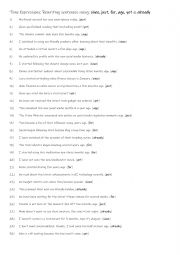
|
B1 Time Expressions Rewriting sentences using since, just, for, ago, yet & already
Rephrasing helps students understand the content better by forcing them to process and express ideas in their own words. Learning to rephrase properly helps students avoid plagiarism by expressing ideas in their own words rather than copying text directly. Mastering the skill of rephrasing can boost students� confidence in their language abilitie...
Level: intermediate
Age: 10-100
Type:
Downloads: 102
|
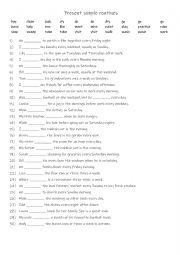
|
A1+-A2 Present simple routines + 3rd person practise
Learning present simple routines with these verbs is useful because it helps describe everyday actions in English, which is important for basic conversation. The present simple tense is used to talk about habits and routines, so knowing these verbs allows students to share information about daily life, like "I wash dishes every evening" or "She vis...
Level: elementary
Age: 8-100
Type:
Downloads: 129
|
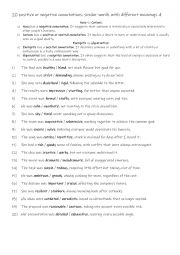
|
20 positive or negative connotations similar words with different meanings 4
First, students need to familiarise themselves with the sentences with 20 connotations and check their meaning of each word. Then they read the sentences to see which one is best to complete the sentence. Answers on page 2.
Level: intermediate
Age: 9-100
Type:
Downloads: 120
|
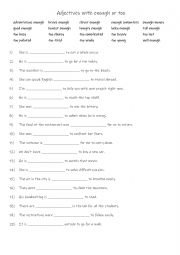
|
A2-B1 Adjectives with enough or too
Learning how to use adjectives with enough and to is important because it helps students express the right degree of a quality or characteristic. These constructions help them clearly communicate whether something meets, exceeds, or falls short of a certain standard or expectation. Answers on page 2.
Level: elementary
Age: 8-100
Type:
Downloads: 120
|
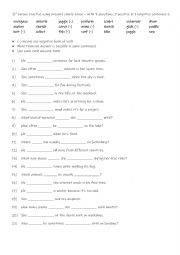
|
3rd person practise using present simple tense � with positive & negative sentences + questions 5
Students familiarise themselves with the 21 verbs. Then they read the sentences to see which question verb is required to complete the gap-fill. Each form is used 7 times! Answers on page 2.
Level: elementary
Age: 8-100
Type:
Downloads: 158
|
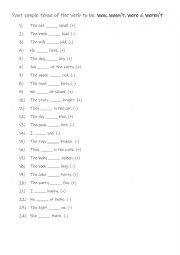
|
A1 Past simple tense of the verb to be: was, wasn�t, were & weren�t
Students read the sentences and complete it using the correct form of the verb to be. Answers on page 2
Level: elementary
Age: 8-100
Type:
Downloads: 129
|
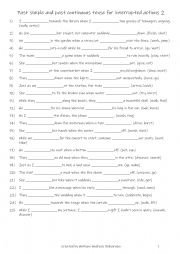
|
A1+-A2 Past simple and past continuous tense for interrupted actions 2
Learning the past simple and past continuous tenses for interrupted actions is essential because they help students describe events that were happening in the past when something else occurred. The past continuous is used to show the action that was in progress at a specific time in the past, while the past simple is used to describe the action tha...
Level: elementary
Age: 8-100
Type:
Downloads: 104
|
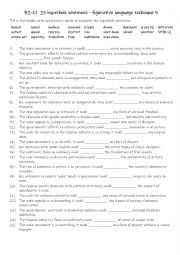
|
B2-C1 25 hyperbole sentences- figurative language technique 5
Recognising and using hyperbole sharpens analytical thinking, as students learn to interpret exaggerated expressions in context. Overall, mastering this figurative language technique makes both written and spoken communication more compelling and expressive. First, students need to familiarise themselves with the 25 words and their meaning. Then th...
Level: intermediate
Age: 12-100
Type:
Downloads: 113
|
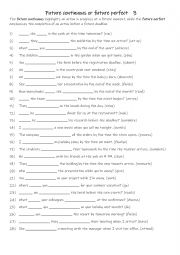
|
A2+-B1 Future continuous or future perfect 3
First, students need to familiarise themselves with the 2 tenses and their use. Then they read the sentences to work out which tense is needed to complete the gap-fill using the infinitive in (). Each tense is used 12 times! Answers on page 2
Level: intermediate
Age: 9-100
Type:
Downloads: 121
|
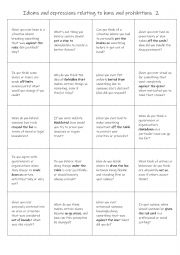
|
B1+-C1 Idioms and expressions relating to bans and prohibitions 2
This is a speaking reinforcement activity to supplement the other worksheet I uploaded on 10/2/2025. Students working in pairs or small groups can either ask each other the questions or answer the question themselves.
Level: intermediate
Age: 12-100
Type:
Downloads: 110
|












